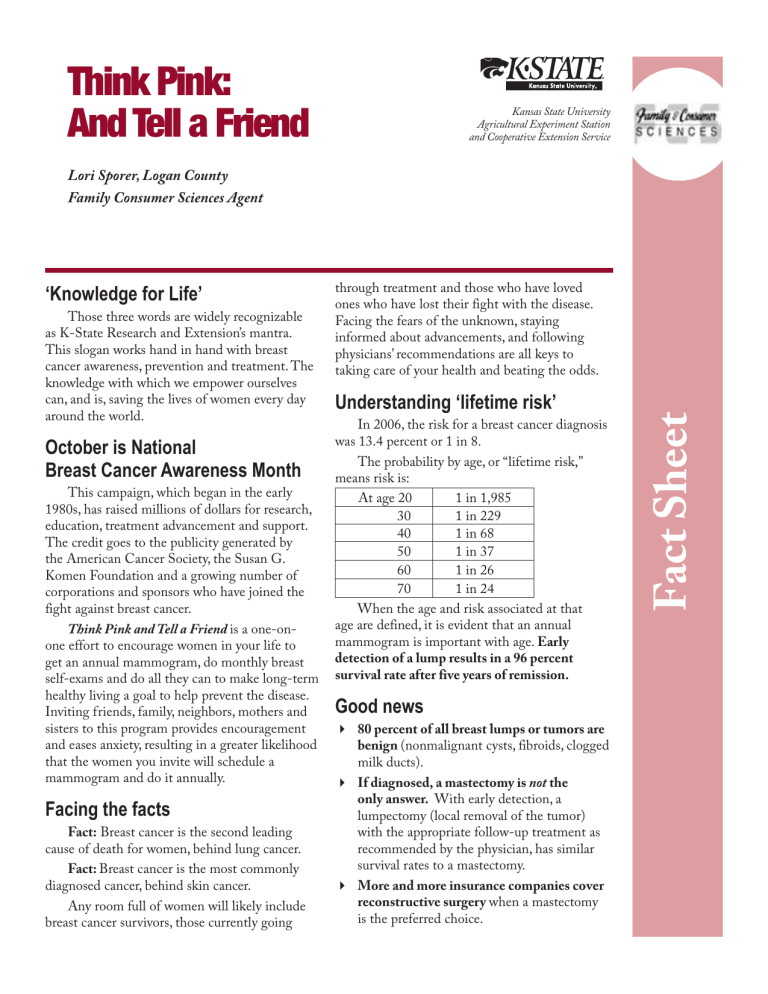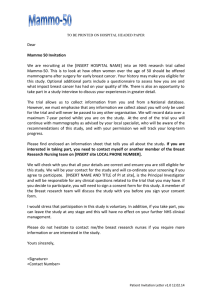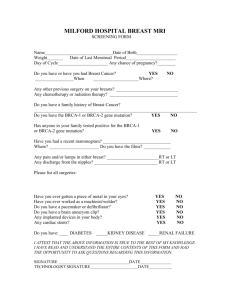Think Pink: And Tell a Friend ‘Knowledge for Life’ Lori Sporer, Logan County

Think Pink:
And Tell a Friend
Lori Sporer, Logan County
Family Consumer Sciences Agent
Kansas State University
Agricultural Experiment Station and Cooperative Extension Service
‘Knowledge for Life’
Those three words are widely recognizable as K-State Research and Extension’s mantra.
This slogan works hand in hand with breast cancer awareness, prevention and treatment. The knowledge with which we empower ourselves can, and is, saving the lives of women every day around the world.
October is National
Breast Cancer Awareness Month
This campaign, which began in the early
1980s, has raised millions of dollars for research, education, treatment advancement and support.
The credit goes to the publicity generated by the American Cancer Society, the Susan G.
Komen Foundation and a growing number of corporations and sponsors who have joined the fight against breast cancer.
Think Pink and Tell a Friend is a one-onone effort to encourage women in your life to get an annual mammogram, do monthly breast self-exams and do all they can to make long-term healthy living a goal to help prevent the disease.
Inviting friends, family, neighbors, mothers and sisters to this program provides encouragement and eases anxiety, resulting in a greater likelihood that the women you invite will schedule a mammogram and do it annually.
Facing the facts
Fact: Breast cancer is the second leading cause of death for women, behind lung cancer.
Fact: Breast cancer is the most commonly diagnosed cancer, behind skin cancer.
Any room full of women will likely include breast cancer survivors, those currently going through treatment and those who have loved ones who have lost their fight with the disease.
Facing the fears of the unknown, staying informed about advancements, and following physicians’ recommendations are all keys to taking care of your health and beating the odds.
Understanding ‘lifetime risk’
In 2006, the risk for a breast cancer diagnosis was 13.4 percent or 1 in 8.
The probability by age, or “lifetime risk,” means risk is:
At age 20
30
40
50
60
70
1 in 1,985
1 in 229
1 in 68
1 in 37
1 in 26
1 in 24
When the age and risk associated at that age are defined, it is evident that an annual mammogram is important with age. Early detection of a lump results in a 96 percent survival rate after five years of remission.
Good news
4 80 percent of all breast lumps or tumors are benign (nonmalignant cysts, fibroids, clogged milk ducts).
4 If diagnosed, a mastectomy is not the only answer. With early detection, a lumpectomy (local removal of the tumor) with the appropriate follow-up treatment as recommended by the physician, has similar survival rates to a mastectomy.
4 More and more insurance companies cover reconstructive surgery when a mastectomy is the preferred choice.
4 Research is making new treatment options available. Here are a few examples:
~ Vaccines can help the body make antibodies.
~ T-cell and stem cell research has grown dramatically.
~ Cryosurgery literally freezes tumors, halting their spread and growth, and killing the tumor.
~ New laser therapy heats and destroys tumors.
4 The survival rate is now up to 96 percent with an early diagnosis and five years of remission.
Why are women beating the odds?
4 Regular annual mammograms leading to early detection.
4 Improving lifestyles that prevent breast cancer and other illnesses.
4 Advancements in cancer care, medications and treatment.
4 Health-care consumers are becoming more empowered with knowledge, asking questions and seeking information.
Regardless of how much women dread it, hate it, whether or not it is painful … big or small, young or old: An annual mammogram is the champion of early detection.
In a 2006 WebMD Health Poll, women between the ages of 40 and 60 were asked “Have you had a mammogram?” The results were:
4 25 percent said, “No, I’m too young.”
4 37 percent said, “No, but I probably should get one.”
4 12 percent said, “Yes, but not every year.”
4 Only 26 percent said, “Yes. Annually and on schedule.”
For those 26 percent who are diligent in their health-care screening, women who had regular mammograms showed a significantly reduced death rate from the disease.
Because of early detection, regardless of the stage of cancer when diagnosed, more than 90 percent of women live longer than 10 years after that diagnosis.
The American Cancer Society and American
Medical Association recommend annual mammograms starting at age 40, or 30 for women at “high risk.”
What are the risk factors?
Culture and traditions play a huge role in the increasing rates of breast cancer diagnosis and many other illness and diseases. Below are a few critical lifestyle issues that increase risk:
Obesity. There is evidence that weight gain during or after menopause may contribute to increased risk. (Mayo Clinic)
Dietary intake. High-fat foods and highly processed foods may increase risk. Fruits, vegetables and whole grains help lower that risk.
Lack of exercise. In addition to helping maintain weight, regular exercise helps decrease stress, another contributor to breast cancer risk.
Smoking. Smoking raises your risk of many, if not all, cancers. Quitting cuts risk by 50 percent in just two years. Both smoking and secondhand smoke increase the risks involved.
HRT: Hormone Replacement Therapy.
Hormone replacement, usually a combination of estrogen and progestin, is commonly used to relieve the symptoms of menopause. Based on evidence from the National Cancer Institute, combination HRT is associated with a 24 percent increased risk of breast cancer. Know the risks, stay informed and continue medical supervision of
HRT.
Alcohol. Alcohol is consistently associated with breast cancer, as well as other cancers, along with stroke and heart disease. Two drinks a day can increase the risk over an extended period of time by 21 percent.
Family history of the disease. Your physician and health care team need to be aware of an immediate family member’s diagnosis, because it could place you in a higher risk category. But only 10 percent of all breast cancer diagnoses are associated with heredity. In 90 percent of the cases, cells became cancerous with no known cause.
What about prevention?
Breast cancer should be treated like other serious chronic conditions that we strive to prevent. Long-term good health helps prevent not only breast cancer, but also osteoporosis, high blood pressure, stroke, heart disease and diabetes.
Small steps can become bigger steps toward long-term health goals. Focus on manageable changes, then add new goals.
The following lifestyle choices help you in prevention of breast cancer and many other illnesses:
1. Follow MyPyramid from USDA. Enjoy a low fat diet every day. (For more detailed information about activity, health and food choices, visit mypyramid.gov
or refer to K-
State Research and Extension publication
MF2686, Steps to a Healthier
You: A
Summary of the
2005 Dietary
Guidelines for
Americans and the Food Guide/MyPyramid .)
2. Five a day.
Strive to eat five to nine servings each day of fruits and vegetables. Visit www.fruitsandveggiesmatter.gov/ for more information.
3. Make yours whole. Enjoy healthful whole grains, breads, cereals and snacks. Popcorn, oatmeal and many breakfast cereals are now made with whole grains.
4. Eat two servings a day of healthy proteins.
Fish, chicken, nuts, legumes and lean meats are good choices.
5. Stay hydrated.
Drink six to eight glasses of water a day.
6. Rest.
Get at least eight hours of sleep every night.
7. Exercise. Aim for 30-60 minutes of activity, five days a week. If exercising is a struggle, try a local gym, a walking program or the “buddy system” with friends, family or a neighbor. If the costs involved with joining a local gym or workout facility are a concern, consider the money saved in the long run with better health, reduced stress, fewer colds and annual sickness, and decreased body fat. Compare the benefits with the expenses associated with lack of exercise.
Make time for exercise
Everyone has 24 hours in a day. Do the following exercise to help find time to exercise and make lasting, long-term good health changes.
Get a calculator and piece of paper to add up the time used every day.
___ Hours sleeping per night (average)
___ Hours working at your job
___ Time spent on personal care (bathing, make up, hair styling, dressing)
___ Time spent on meal preparation
___ Time spent eating or meal time (lunch hour)
___ Time spent traveling, taking kids to school, driving to work, or errands
___ Time spent on childcare
___ Time spent on housework (picking up, dusting, folding laundry)
___ Time spent cleaning up the kitchen after meals
___ Pet care
The average American has four hours left over at the end of the day. Make exercise a priority, and change your life.
With hope and promise, let’s all “Think Pink,
Tell a Friend,” join hands and repeat the “Tell a
Friend Pledge.”
Today I pledge to my dear friends, to those I love, and on whom I depend.
Today I pledge a monthly check, for changes that she might suspect.
Today I pledge an open door, when questions arise with those I adore.
Today I pledge my support to offer, the encouragement needed to visit her doctor.
Today I pledge to my dear friends, to those I love, and on whom I depend.
Sources for this lesson and information resources
The American Cancer Society at 1-800-ACS-
2345 or www.cancer.org
The Mayo Clinic at www.mayoclinic.com/health/ breast-cancer-prevention
Susan G. Komen Foundation at www.komen.org
The Breast Cancer Site at www.
thebreastcancersite.com
Breast Cancer Risk Calculator at www.halls.md/ breast/risk.htm
The National Breast Cancer Foundation at www.nationalbreastcancer.org/
The National Cancer Institute at www.cancer.
gov/cancertopics/pdq/prevention/breast/ healthprofessionals
Author:
Lori Sporer, Logan County Family Consumer
Sciences Agent
Reviewed by:
Paula Peters, Ph.D., Assistant Director,
Extension Family and Consumer Sciences
Georgetta Schoenfeld, R.N.,
Director, Logan County Health Department
Brand names appearing in this publication are for product identification purposes only.
No endorsement is intended, nor is criticism implied of similar products not mentioned.
Publications from Kansas State University are available on the World Wide Web at: www.oznet.ksu.edu
Publications from Kansas State University may be freely reproduced for educational purposes.
All other rights reserved. In either case, credit Lori Sporer, Think Pink: And Tell a Friend, Fact Sheet ,
Kansas State University, July 2007.
Kansas State University Agricultural Experiment Station and Cooperative Extension Service, Manhattan, Kansas
MF2778 August 2007
K-State Research and Extension is an equal opportunity provider and employer. These materials may be available in alternative formats. Issued in furtherance of Cooperative
Extension Work, Acts of May 8 and June 30, 1914, as amended. Kansas State University, County Extension Councils, Extension Districts, and United States Department of Agriculture
Cooperating, Fred A. Cholick, Director.




